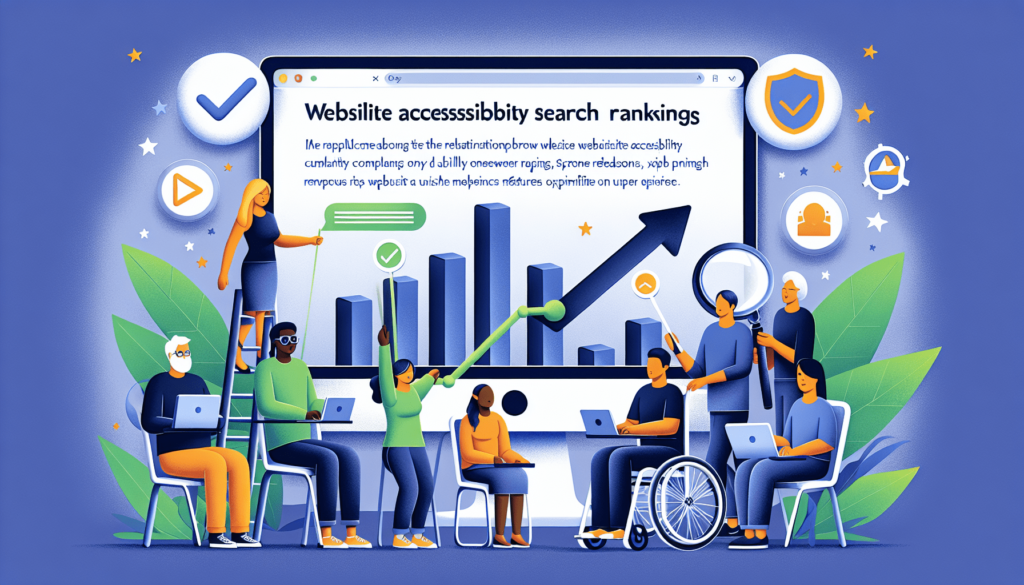Have you ever wondered how accessibility compliance affects search engine rankings? In today’s digital age, optimizing your website’s accessibility is not only important for ensuring a seamless user experience for all visitors, but it can also have a significant impact on your search engine rankings. When search engines assess the quality and relevance of websites, they also take into account factors like accessibility compliance, which includes making your website easily navigable for individuals with disabilities. In this article, we will explore the relationship between accessibility compliance and search engine rankings, as well as the steps you can take to improve both.

The Importance of Accessibility Compliance
Improving User Experience
Ensuring that your website is accessible to all users, regardless of disabilities or impairments, is crucial for providing a positive and inclusive user experience. Accessibility compliance means that all individuals can easily navigate and interact with your website, making it more user-friendly and enjoyable for everyone. By accommodating diverse user needs, you create a welcoming environment that fosters user satisfaction and loyalty.
Increasing Website Traffic
When your website is accessibility compliant, you open the door to a larger audience and potential customers. By designing your website with accessibility in mind, you tap into a market that might have otherwise been excluded. People with disabilities, as well as those who rely on assistive technologies, will be able to access your website and engage with your content. This inclusivity can significantly increase traffic to your website and broaden your user base.
Meeting Legal Requirements
Accessibility compliance is not just a moral obligation, but also a legal requirement in many countries. Different countries have laws and regulations in place, such as the Americans with Disabilities Act (ADA) in the United States and the Equality Act in the United Kingdom, to ensure that websites are accessible to all individuals. Failure to comply with these regulations can lead to legal actions and penalties. By prioritizing accessibility compliance, you protect your business from legal repercussions and demonstrate your commitment to equality and inclusivity.
Key Factors in Accessibility Compliance
Web Content Accessibility Guidelines (WCAG)
The Web Content Accessibility Guidelines (WCAG) are internationally recognized standards for making web content accessible to individuals with disabilities. These guidelines provide a framework for developers and designers to follow in creating accessible websites. From providing alternative text for images to ensuring keyboard accessibility, WCAG covers a wide range of accessibility requirements and best practices. Adhering to WCAG guidelines not only ensures compliance but also guarantees that your website is accessible to a diverse range of users.
Responsive Design and Mobile Accessibility
With the increasing use of mobile devices, it is essential to make your website accessible and responsive across different screen sizes. Responsive design allows your website to adapt and provide an optimal user experience, regardless of the device being used. This includes ensuring touch targets are large enough for easy navigation, text is readable without zooming, and content reflows appropriately. By prioritizing mobile accessibility, you make your website accessible to users on the go, thereby increasing engagement and potentially attracting more mobile-driven traffic.
Alternative Text for Images
Including alternative text, also known as alt text, for images is critical for users with visual impairments. Alt text serves as a textual description of the image content, allowing individuals using screen readers or other assistive technologies to understand the visual elements on your website. By providing descriptive alt text, you ensure that users with disabilities can comprehend the context and purpose of images and graphics, enhancing their overall browsing experience.
Clear and Descriptive Headers
Clear and descriptive headers are essential for users with visual impairments, as well as individuals who use screen readers. Headers provide structure and organization to your web content, allowing users to navigate easily and understand the hierarchy of information. By using proper heading tags and ensuring consistent and logical header structure, you create a more accessible and user-friendly experience for all visitors.
Text-to-Speech Technology
Text-to-speech technology, such as screen readers, plays a vital role in ensuring accessibility for individuals with visual impairments or reading difficulties. By structuring your content in a way that can be easily understood by screen readers, you enable users to access the information on your website through audio output. This feature allows those who cannot read or see the content to experience your website effectively, thereby improving accessibility and user engagement.
Keyboard Accessibility
Keyboard accessibility is crucial for individuals with mobility impairments or those who cannot use a mouse or other pointing devices. By designing your website to be fully navigable and functional using only a keyboard, you provide equal access to individuals with physical disabilities. Keyboard accessibility includes ensuring that all interactive elements, such as buttons and links, can be easily selected and activated using keyboard commands. Making your website keyboard-friendly ensures that everyone can interact with your content, regardless of their physical abilities.
Color Contrast and Readability
Considering color contrast when designing your website is essential for individuals with visual impairments, including color blindness. Ensuring sufficient contrast between text and background colors enables users with low vision to read and comprehend the content easily. Additionally, using clear and legible fonts, appropriate font sizes, and proper line spacing contributes to overall readability for all users, including those with visual impairments or learning disabilities.

Search Engine Ranking Factors
Quality Content
Creating high-quality and relevant content is a fundamental aspect of search engine optimization (SEO). Search engines strive to provide users with the most relevant and reliable information, and quality content plays a significant role in achieving this goal. By producing valuable content that meets the needs of your target audience, you increase the chances of ranking higher in search engine results pages (SERPs).
Metadata and Structured Data
Metadata and structured data provide search engines with valuable information to understand and index your website accurately. By optimizing your metadata, such as meta titles and descriptions, you improve the visibility and relevance of your web pages in search results. Structured data, represented using Schema.org markup, further enhances the understanding of your content, enabling search engines to display rich snippets and other enhanced search result features.
Website Load Speed
Website load speed is a critical ranking factor that influences user experience and search engine rankings. Slow-loading websites can frustrate users and lead to high bounce rates, negatively impacting your SEO efforts. Optimizing your website’s performance, including image optimization, caching, and minimizing unnecessary code, improves load speed, ensuring a smooth and efficient user experience that search engines value.
Mobile-Friendly Design
With the increasing use of mobile devices for browsing, having a mobile-friendly website is crucial for both user experience and SEO. Search engines prioritize mobile-friendly websites in their mobile search results, as they want to provide the best possible experience for mobile users. By adopting responsive design principles and optimizing your website for mobile devices, you improve your chances of ranking higher in mobile search results.
Backlinks and Domain Authority
Backlinks from authoritative websites are important indicators of your website’s credibility and relevance to search engines. High-quality backlinks signal to search engines that your content is valuable and trustworthy, ultimately improving your chances of ranking higher. Domain authority, which measures the overall strength and trustworthiness of your website, also plays a significant role in search engine rankings. By focusing on building authoritative backlinks and improving your domain authority, you enhance your SEO efforts.
User Engagement Metrics
User engagement metrics, such as click-through rates (CTR), time on page, and bounce rates, provide valuable insights into how users interact with your website. Search engines take these metrics into consideration when determining the relevance and quality of your content. By creating engaging and user-friendly experiences, you increase the likelihood of users staying on your website longer, exploring more pages, and taking desired actions, all of which can positively impact your search engine rankings.
The Impact of Accessibility Compliance on Search Engine Rankings
Improved User Experience Signals
Accessibility compliance directly contributes to improved user experience, which search engines value highly. When users can easily navigate and interact with your website, find the information they need, and accomplish their goals, they are more likely to stay on your site and engage with your content. Positive user experience signals, such as longer time on site, low bounce rates, and higher conversion rates, can positively influence your search engine rankings.
Higher Visibility and Website Traffic
By ensuring accessibility compliance, you open your website to a wider audience, including individuals with disabilities and those who rely on assistive technologies. This increased accessibility improves the visibility and reach of your website, leading to higher organic traffic from targeted audiences. As search engines prioritize inclusive and accessible websites, your chances of appearing in relevant search results and attracting more users significantly increase.
Positive Effects on SEO Factors
Accessibility compliance often aligns with best practices for SEO. Many accessibility guidelines, such as providing descriptive alt text for images and using clear headers, also enhance the structure and readability of your content, making it easier for search engines to crawl and understand your website. By focusing on accessibility, you improve SEO factors such as keyword optimization, content organization, and user-friendly design.
Better User Engagement Metrics
When your website is accessible, users are more likely to engage with your content, resulting in improved user engagement metrics. Users with disabilities who can access and navigate your website effortlessly are more inclined to spend time exploring your content, accessing different pages, and taking desired actions. These positive user engagement signals, including longer time on site, increased page views, and lower bounce rates, can have a direct impact on your search engine rankings.
Enhanced Mobile Accessibility
Accessibility compliance often goes hand in hand with mobile accessibility. By prioritizing responsive design and mobile-friendly practices, you make your website accessible and user-friendly for mobile users. As search engines increasingly prioritize mobile search results, having an accessible mobile website can significantly impact your visibility and rankings in mobile searches. By embracing accessibility, you ensure that all users, regardless of their device, have a seamless and satisfying mobile experience.
Case Studies and Examples
Websites Penalized for Inaccessibility
Multiple cases have emerged where websites have faced legal actions and penalties due to their inaccessibility. Famous examples include retail giant Target and media network Netflix. Both companies faced lawsuits for failing to provide accessible websites for individuals with disabilities, resulting in negative publicity and significant financial costs. These cases highlight the importance of accessibility compliance to avoid legal repercussions and maintain a positive reputation.
Websites Benefiting from Accessibility Compliance
Many companies have recognized the value of accessibility compliance and reaped the benefits in terms of improved rankings and increased website traffic. Companies like Apple, Microsoft, and Starbucks have made accessibility a priority, ensuring that their websites are accessible to all users. By implementing accessibility best practices and considering the diverse needs of their audience, these companies have enhanced user experience, increased engagement, and solidified their positions as leaders in their respective industries.
Steps to Achieve Accessibility Compliance
Conducting an Accessibility Audit
To ensure accessibility compliance, it is crucial to conduct an accessibility audit of your website. An accessibility audit involves evaluating your website’s design, structure, and content to identify any accessibility barriers or non-compliance with WCAG guidelines. Conducting an audit helps you identify areas for improvement and create an actionable plan for achieving accessibility compliance.
Implementing WCAG Guidelines
The Web Content Accessibility Guidelines (WCAG) serve as a comprehensive reference for achieving accessibility compliance. Implementing WCAG guidelines entails addressing specific requirements and recommendations, such as providing alt text for images, ensuring keyboard accessibility, and optimizing color contrast. By following WCAG guidelines, you establish a solid foundation for accessibility compliance and create an inclusive digital experience for all users.
Training and Education
Ensuring accessibility compliance requires educating and training your development and design teams. It is essential to provide training on WCAG guidelines, accessibility best practices, and assistive technologies. By equipping your teams with the necessary knowledge and skills, you empower them to create accessible websites and maintain compliance in future updates. Regular training and education also foster a culture of accessibility within your organization.
Continuous Monitoring and Maintenance
Accessibility compliance is not a one-time effort; it requires ongoing monitoring and maintenance. Regularly reviewing your website’s accessibility, addressing any issues or barriers, and ensuring that new content and updates remain accessible is crucial. Implementing automated accessibility testing tools and involving users with disabilities in usability testing can help you identify and fix accessibility issues promptly.
The Future of Accessibility Compliance and SEO
Increasing Emphasis on Accessibility
As society becomes more aware of the importance of inclusivity and accessibility, the emphasis on accessibility compliance is likely to grow. Organizations are recognizing the impact of accessibility on user experience, legal requirements, and search engine rankings. The push for accessibility will intensify, making it essential for businesses to proactively embrace accessibility compliance and engage all users, regardless of disabilities or impairments.
Voice Search and Accessibility
Voice search is rapidly gaining popularity, with devices like smart speakers and voice assistants becoming increasingly common. Accessibility compliance will play a significant role in enabling individuals with disabilities to access voice search technology. By ensuring that voice interfaces and devices are designed with accessibility in mind, organizations can promote inclusivity and make voice search accessible to all users.
Advancements in Assistive Technologies
The field of assistive technologies is evolving at a rapid pace. With advancements in technologies like screen readers, voice recognition, and gesture-based interfaces, individuals with disabilities are gaining greater access to digital content and services. Keeping up with these advancements and embracing accessibility will become increasingly important for organizations aiming to provide an inclusive online experience.
Conclusion and Recommendations
Prioritizing Accessibility Compliance
Accessibility compliance should be a top priority for any organization with an online presence. By designing and developing accessible websites, businesses demonstrate their commitment to inclusivity and enhance the user experience for all individuals, regardless of disabilities or impairments.
Regularly Updating and Optimizing
Accessibility compliance is not a one-time task; it requires continuous updates and optimization to address new guidelines, technologies, and user needs. Regularly reviewing your website, conducting audits, and implementing improvements ensures that your website remains accessible and compliant.
Seeking Professional Help if Needed
If you are unsure about the accessibility compliance of your website or lack the expertise to implement it properly, seeking professional help from accessibility consultants or web development agencies specializing in accessibility can be beneficial. They can guide you through the process, conduct accessibility assessments, and provide tailored solutions based on your specific needs.
By making your website accessibility compliant, you not only improve the user experience for all visitors but also enhance your search engine rankings. Accessibility compliance provides numerous benefits, including increased website traffic, improved user engagement metrics, and compliance with legal requirements. Additionally, accessibility compliance aligns with essential SEO factors such as quality content, mobile-friendliness, and user-friendly design. As the importance of accessibility continues to grow, investing in accessibility compliance is a smart business decision that can positively impact your online presence and ensure equality for all users.


